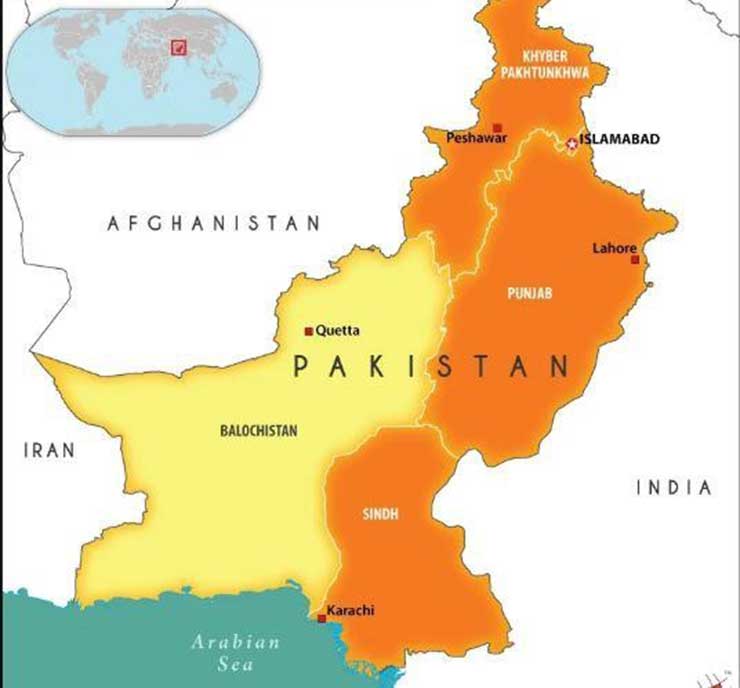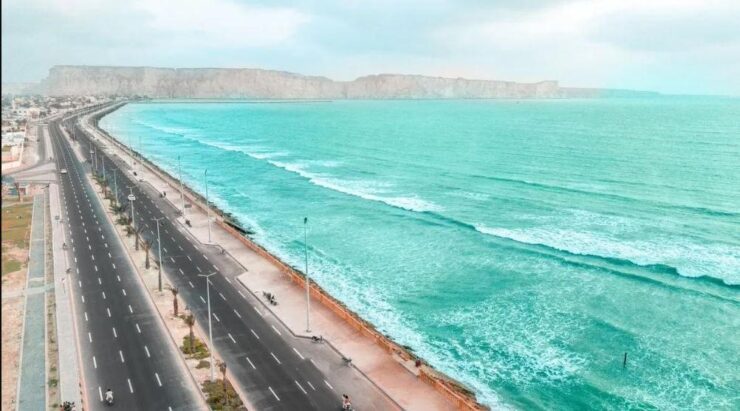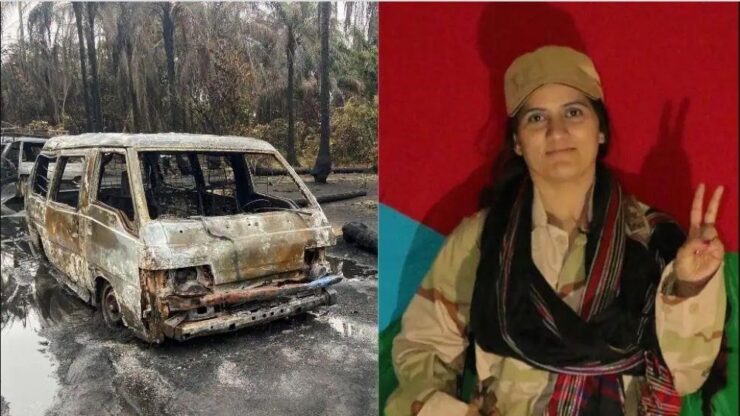
Balochistan is one of the four constituents of Pakistan, our immediate western neighbour. Punjab, Sindh, and Khyber Pakhtunkhwa are the other three. Balochistan, located in the southwestern region, is the largest in terms of the landmass coverage of 347,100 sq km (44 per cent) area but the least populated province, with only 8 per cent of the total population (1.23 crore) dwelling there. Balochistan shares 832 km frontiers with Iran in the west and Afghanistan to the north and northwest, Kyber Pakhtunkwah in the north, Punjab in the northeast, Sindh in the east, and the Arabian Sea in the south near the Strait of Hormuz. The important factor is that it does not share borders with India. The provincial capital is Quetta, a beautiful city and a major cantonment. Turbat and Gwadar port are the other important townships.
Balochistan also called ‘the Land of Baloch’ is located on the eastern edge of the Iranian plateau. The Sulaiman Mountains dominate the northern dry and arid region with a scarcity of water. Bolan pss is the southern gateway to Afghanistan and on the famous trade route between Quetta and Kandahar. The central region is called Kalat and the southwestern region is dominated by a desert called Kharan and the southern tip is the beautiful Makran coastal area. The entire region is rich in natural resources. It has large natural gas reserves enough to supply to the whole of Pakistan for the next 20 years. The climate of the highlands is extreme. Hot summers rise up to +55 degrees Celsius and extreme cold in winters falls below -20 degrees Celsius. Sand storms are common in the desert area. The coastal areas of Markan and Gwadar have milder climates. The entire area is an earthquake-prone belt.
History of the region
Balochistan inherits an older civilisation than the Indus valley. Before the arrival of Islam, the region was ruled by Pratarajas of the Indo-Scythian dynasty followed by Kushan Kings and the Sewa dynasty. In 654 CE, Balochistan was conquered by Abdul Rehman Samath of the Rashidun caliphate followed by the Ummayad Caliphate. In the 15th century, it came under the rule of Mir Chakar Khan Rind, a close aid of Himayun who united Afghani, Irani, and Indian Balochistan and termed Greater Balochistan, and was succeeded by the Khanate of Kalat. They supported Nadir shah and later Ahmed Shah Durrani and fought under Moghuls in the third battle of Panipat. British forces took control of four princely states of Makran, Kharan, Las Bela and Kalat in 1873.
The second Afghan war was terminated after the treaty of Gandmark in May 1879 and Quetta, Pishin, Harnai, Sibi and Chotiali came under British control and were declared British territory. Strategic Bolan pass connecting Quetta to Kandahar was occupied by the British in 1883. Durand Line, 4250 km long, became the frontier between Afghanistan and British India in 1893 as an agreement was concluded between Sir Mortimer Durand and Amir of Afghanistan.
Seeds of insurgency
After the declaration of Independence, Ahmad Yar Khan took over the Khanate of Kalat and was aspiring for an independent country, but was given a choice to join either Pakistan or India. He finally acceded to Pakistan on 27 March 1948. His brothers Abdul Karim and Mohmmad Rahim revolted against the decision and started an underground movement called Dosht-e-Jhalwan. Thus, seeds of the insurgency were sown in 1948. The group carried out attacks on Pakistani security forces (SFs). The insurgency by Baloch nationalists is basically against suppression, exploitation and atrocities committed by three nations: Pakistan, Iran and Afghanistan. The main demand of the armed groups is political autonomy, better control of natural resources and the development of the region.
The Baloch insurgent groups include the Baloch Liberation Army, Baloch Liberation Front, Baloch Student Organisation, Baloch Revolutionary Army, and United Baloch Army. The sectarian groups are: Ansar al Fuqan, Jaish UL Adl, Jandollah Iran, Tehrik i Taliban Pak, Lashkar e Jhanngvi, and Sipah e Sahaba.

The main ethnic group is the Baluch tribe with several sub-tribes forming 60 per cent of the total population; 25 per cent are Pashtuns and the balance is other smaller communities such as Hazaras, Uzbeks, Sindhis and Punjabis. There are about 130 Baloch tribes with two lakh tribals dwelling in the mountain region of Dera Bugti. The main sub-tribes are Rahija Bugti, Masori Bugti and Kalapar Bugti. Akbar Khan was the leader of the prominent Rahija Bugti tribe and held important appointments. He was head of the Jhamoori Watan Party. He demanded 39 % royalty from the government in ownership of gas fields. He was killed in 2006 in military ops. His sons did not accept the Pakistani government’s offer of negotiation and took up militancy.
The Marri is another major tribe based in the Kohlo district. Nawab Khair Baksh Marri is the head. Marri tribe has three sub-tribes Ghazni, Bejarani and Kon with a nearly 80,000 population, and they are pro-Russian. They advocate full independence. His son Balach Marri is head of the militant group BLA. Atalluha Khan Mengal is the leader of Mingal tribe and is a pro-Pakistan government. Ataullah became the first CM of Baluchistan. He was later imprisoned in 1973 and a large-scale operation was launched to suppress the independence movement. He went into exile in London and formed the Baloch National Party (BNP). His son became CM but was jailed by Musharaf in 2009 for treason.
Phases of insurgency
The first phase of insurgency was initiated in March 1948 itself, as an instrument of accession was signed by Yar Khan, the Khan of Kalat, by his younger brothers. It continued till the dissolution of the province in 1955. The second round of conflict was started in 1958 by Nawab Nauroz Khan against the One-Unit Policy, which decreased the representation of tribal leaders in the federal government. He launched guerrilla warfare against Pak SFs. He was arrested in Hyderabad and imprisoned for treason and his five family members were hanged and he was tortured to death in prison. He was the lone fighter and was not supported by locals.
The third phase of insurgency lasted from 1963 to 1969 following the introduction of the new constitution with strong control of the central government under the One-Unit Policy. Tension mounted as the present federal government allotted vast areas for military bases and reduced the role of local tribal leaders. Sher Mohammad Bijrani Marri reorganised the various factions and created the Baloch United Front and started the guerrilla operations against Pak Armed Forces. He established about 50 insurgent bases from the northern Bugti and Marri region to the southern Mengal belt.
The main demand of the militant groups was that enormous revenue generated by the government should be shared with tribal leaders for the development of the region. The insurgents resorted to ambush convoys of SFs and also blew up bridges and railway tracks. The army launched a massive military operation and hundreds of insurgents were killed/apprehended. The ceasefire was announced in 1970 as Pakistan’s president agreed to abolish the One Unit Policy and recognised Balochistan as the fourth province of Pakistan including all princely states, Central-ruled areas and Gwadar, an area of 800 sq km purchased by Pakistan from Oman in 1958. The fourth phase of militancy was triggered in 1973 as martial law was imposed in two western provinces – Balochistan and Northwest Frontier Province by then-president Z A Bhutto to suppress the unrest and violence. The top tribal leaders were arrested and counter-insurgency operations were launched. Mir Hazar Ramkhani formed the Balochistan Peoples Liberation Front and assembled all major tribes. They undertook various covert operations and had head-on clashes with Pak troops. It was the most dangerous phase of militancy.
Nearly 500 Pak troops were killed and the same number severely wounded whereas 3000 Balochi militants and 6000 civilians suspected to be OGWs were brutally killed. The main reason for heavy militant/civilian casualties was that It was a joint operation by the armies of Iran and Pakistan.
The militancy declined after 1975 and remained dormant till 2004 as the central government accepted equal status to all four provinces and abolished the Sardari system. The fifth phase of insurgency revived in 2005, as the Chinese arrived at Gwadar Economic Zone. Nawab Akbar Khan Bugti and Baiach Marri submitted a memorandum to the Pakistan government to provide more development funds to Balochistan and impose a moratorium on the construction of more military bases in the tribal belt. The situation became critical as a team of Chinese engineers working on Gwadar Port were ambushed resulting in three killed and four critically injured. The Chinese government expressed shock and told the Pak authorities to take suitable action for the safety of Chinese workers in the Gwadar Port complex. On 15 December 2005, the helicopter carrying Maj Gen Shujaat Dar and Brig Salim Nawaaz of Pak Frontier Corps was fired upon in Kohlu area, northern Balochistan but they survived although suffered gunshot wounds.

Later, militants fired at President Musharaf’s helicopter also. Nawab Akbar Khan Bugti was killed in a military operation along with nearly 100 insurgents in 2006. Pak military casualties were also heavy with seven officers and 70 troops killed in the operation. In April 2009, Baloch Nationalist Movement leaders Gulam Mohammad Baloch, Lala Munir and Sher Mohmmad were abducted from their office by unknown gunmen and on 8 April 2009 their bullet-ridden bodies were found on the road. BLA accused Army of the killings but the Pak army denied any involvement. The killings led to strikes, demonstrations and civil unrest. The government offices and vehicles were set ablaze. To add fuel to fire, Mir Suleman Dawood Khan of Kalat declared himself ruler of Balochistan and announced his cabinet on 12 August 2009. Again, the large-scale operations were launched to subdue the rebels.
Chinese are the new targets
The China Pak Economic Corridor CPEC has added a new dimension to the Balochistan uprising. An MOU was signed between the two countries in 2013 to develop a series of economic zones connecting, upgrading northeast Pakistan to southwest Pakistan in two rail-road corridors linking Kashgar in the Xinjiang region of Tibet to Gwadar via Peshawar and Quetta (Western highway ) from Islamabad, Lahore, Rahimyar Khan to Karachi port towns (Eastern route) along with Gas /Oil pipelines and Powerhouses and Solar farms. Balochistan had expressed concerns as they expect that they will be outnumbered by Chinese troops and workers and skilled workers from Punjab and Sindh. The project cost is 62 billion US dollars and is 75 per cent completed. The Chinese are the new targets of Baloch rebels. A bus carrying Chinese engineers was blown up killing 12 soldiers and Chinese staff in 2021 at Khyber Pakhtunkhwa. There were 81 incidents of terrorism in which 100 soldiers and 250 insurgents were killed.
On 23 April 2022, a new dimension has been added to the insurgency. A 30 years old graduate Burqa-clad woman, Shari Balach, in Karachi University blew herself up, as a human bomb and killed three Mandarin teachers of Confucius Chinese Institute. Later, Baloch Liberation Army claimed that the bomber belonged to the Mazid Brigade and will carry out more attacks on foreigners intruding in our motherland. The Chinese government has recalled about 50 Chinese Mandarin teachers from Pakistan as a protest and asked the Pakistani government to ensure the safety of Chinese nationals working on CPEC projects.
Drifting away, gradually
Balochistan insurgency is a threat to three nations – Iran, Afghanistan and Pakistan. The Pakistani authorities have repeatedly accused India of being behind the insurgency, especially after the announcement of the CPEC corridor, and providing logistics support, including weapons and funds. The US has maintained that there is no evidence. On 29 March 2016, the Pakistan government announced that it had apprehended an Indian naval officer Kulbhushan Jadhav and released a video of Jadhav admitting that he was a RAW agent tasked to destabilise Pakistan.
The Indian government says Jadhav was a retired naval officer but operated his own legitimate business in Iran when he was abducted by the ISI and forced to make a statement that the Indian prime minister in his Independence Day speech in 2016 alleged that Baloch people were undergoing human rights abuses in Pakistan and sympathised with them morally. There are few Baloch families staying in India and running peaceful campaigns. India time and again denied any role in the insurgency in Balochistan, but Islamabad knows in heart of its heart, that Balochistan is gradually drifting away and is a lost frontier.
-The writer is an Indian Army veteran and a defence analyst. He has keen interest in Geo-strategic affairs and writes regularly on internal and external affairs issues related to India and neighbours. The views expressed are personal and do not necessarily reflect the views of Raksha Anirveda.








